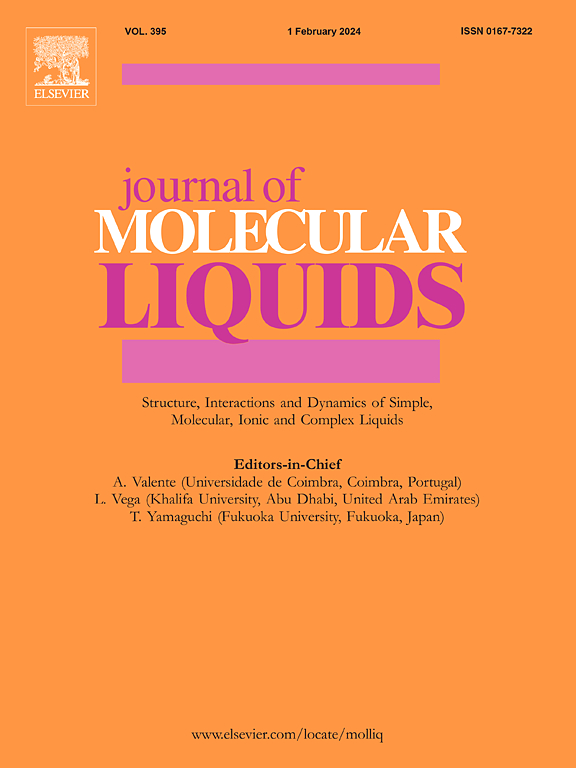Polymer composite nanoarchitectonics with high-porous polyether sulfone/ activated carbon/ cellulose nano-whisker films for adsorptive removal of toxic cationic basic violet 16 dye from wastewater
IF 5.3
2区 化学
Q2 CHEMISTRY, PHYSICAL
引用次数: 0
Abstract
In this study, nanoarchitected composite films with high porosity were created using polyether sulfone (PES), activated carbon (AC), and cellulose nano-whiskers (CNWs) by a phase inversion method at room temperature and atmospheric pressure. The effectiveness of these films was evaluated for the adsorptive removal of the toxic cationic dye, Basic Violet 16 (BV16), from wastewater. The CNWs were extracted from tissue paper, as a cost-effective and easily accessible source of cellulose, using the acidic hydrolysis method and employed in the fabrication of nanocomposite adsorbent films to increase their hydrophilicity. The resulting nanocomposite films were analyzed for hydrophilicity, surface roughness, morphology, thermal stability, and antifungal properties. The results indicated that adding AC and CNW to the PES films improved their thermal stability by approximately 11 to 17 °C.The nanocomposite films containing 1.0 wt% CNWs exhibited the highest hydrophilic properties and the films containing 0.50 wt% AC showed the highest surface roughness as well as the best adsorption performance of BV16 dye, with a maximum adsorption capacity of 89.28 . The adsorption of BV16 by the nanocomposite adsorbent followed the pseudo-second-order kinetic model and the Freundlich isotherm model and was found to have an endothermic nature. The results indicated that the adsorption mechanism is a combination of physical and chemical adsorption. Furthermore, the prepared adsorbent demonstrated promising antifungal properties against Candida albicans and Aspergillus niger. Overall, the study reported good results regarding the antifungal properties and toxic pollutant adsorption performance of PES/AC/CNW nanocomposite adsorbent.

高孔聚醚砜/活性炭/纤维素纳米晶须膜的聚合物复合纳米结构对废水中有毒阳离子碱性紫16染料的吸附去除
在本研究中,以聚醚砜(PES)、活性炭(AC)和纤维素纳米晶须(CNWs)为原料,在室温常压下通过相转化法制备了高孔隙率的纳米复合膜。评价了这些膜对废水中有毒阳离子染料碱性紫16 (BV16)的吸附去除效果。从卫生纸中提取CNWs,作为一种成本效益高且易于获取的纤维素来源,使用酸性水解方法提取CNWs,并用于制备纳米复合吸附剂膜以提高其亲水性。分析了所得纳米复合膜的亲水性、表面粗糙度、形貌、热稳定性和抗真菌性能。结果表明,在PES薄膜中加入AC和CNW可使其热稳定性提高约11 ~ 17℃。含有1.0 wt% CNWs的纳米复合膜具有最高的亲水性,含有0.50 wt% AC的纳米复合膜具有最高的表面粗糙度和对BV16染料的最佳吸附性能,最大吸附量为89.28 mg−1。纳米复合吸附剂对BV16的吸附符合拟二级动力学模型和Freundlich等温模型,并具有吸热性质。结果表明,吸附机理为物理吸附和化学吸附相结合。此外,制备的吸附剂对白色念珠菌和黑曲霉具有良好的抗真菌性能。总的来说,本研究报道了PES/AC/CNW纳米复合吸附剂的抗真菌性能和有毒污染物吸附性能的良好结果。
本文章由计算机程序翻译,如有差异,请以英文原文为准。
求助全文
约1分钟内获得全文
求助全文
来源期刊

Journal of Molecular Liquids
化学-物理:原子、分子和化学物理
CiteScore
10.30
自引率
16.70%
发文量
2597
审稿时长
78 days
期刊介绍:
The journal includes papers in the following areas:
– Simple organic liquids and mixtures
– Ionic liquids
– Surfactant solutions (including micelles and vesicles) and liquid interfaces
– Colloidal solutions and nanoparticles
– Thermotropic and lyotropic liquid crystals
– Ferrofluids
– Water, aqueous solutions and other hydrogen-bonded liquids
– Lubricants, polymer solutions and melts
– Molten metals and salts
– Phase transitions and critical phenomena in liquids and confined fluids
– Self assembly in complex liquids.– Biomolecules in solution
The emphasis is on the molecular (or microscopic) understanding of particular liquids or liquid systems, especially concerning structure, dynamics and intermolecular forces. The experimental techniques used may include:
– Conventional spectroscopy (mid-IR and far-IR, Raman, NMR, etc.)
– Non-linear optics and time resolved spectroscopy (psec, fsec, asec, ISRS, etc.)
– Light scattering (Rayleigh, Brillouin, PCS, etc.)
– Dielectric relaxation
– X-ray and neutron scattering and diffraction.
Experimental studies, computer simulations (MD or MC) and analytical theory will be considered for publication; papers just reporting experimental results that do not contribute to the understanding of the fundamentals of molecular and ionic liquids will not be accepted. Only papers of a non-routine nature and advancing the field will be considered for publication.
 求助内容:
求助内容: 应助结果提醒方式:
应助结果提醒方式:


